In This Issue:
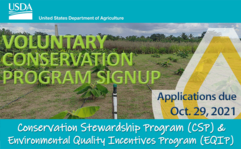
USDA Natural Resources Conservation Service (NRCS) Caribbean Area Director, Luis Cruz-Arroyo, announces the first sign-up period for fiscal year 2022 Conservation Stewardship Program (CSP) and Environmental Quality Incentives Program (EQIP) funding to address farmers’ natural resource concerns.
EQIP is a voluntary conservation program that provides financial and technical assistance to farmers and ranchers to help apply conservation practices on eligible agricultural land. Through EQIP, NRCS helps farmers in Puerto Rico and the U.S. Virgin Islands to improve agricultural production and environmental quality. CSP is a voluntary program that helps farmers build on existing conservation efforts while strengthening operations. Whether you are looking to improve grazing conditions, increase crop yields, or develop wildlife habitat, we can custom design a CSP plan to help you meet those goals.
CSP and EQIP applications are accepted year-round, however, NRCS sets application “cut-off” or submission deadlines to evaluate, rank and approve eligible applications. The following are the cut-off dates for fiscal year 2022:
- CSP & EQIP Period 1 cut-off date: October 29, 2021
- CSP & EQIP Period 2 cut-off date: April 29, 2022
Visit www.pr.nrcs.usda.gov or contact your local USDA-NRCS office to apply.
^ back to top
|

USDA is investing up to $50 million in cooperative agreements to support historically underserved farmers and ranchers with climate-smart agriculture and forestry. The Racial Justice and Equity Conservation Cooperative Agreements are available to entities and individuals for two-year projects that expand the delivery of conservation assistance to beginning, limited resource, socially disadvantaged and veteran farmers. Applications must be received by 11:59 p.m. Eastern Standard Time on October 25, 2021. See the grants.gov announcement for details and application instructions.
^ back to top
|
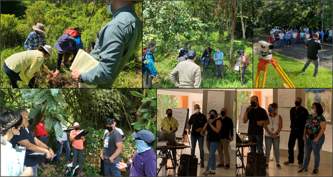
Our NRCS conservationists are continually updating their knowledge and skills to use science-based technology, tools, and applications to provide sound natural resources conservation assistance to our Caribbean Area farmers. From August 2-6 NRCS Caribbean Area held a week-long Conservation Planner Training in Utuado, PR, to train our team on the agency’s newest techniques and updated practices.
Throughout the week staff spent half the day in the classroom and the rest of the day conducting field assessments – refreshing their skills and learning new tools for our 9-step Conservation Planning Process. These steps provide the foundation for the advice NRCS conservationists give our farmers to help them select the best combination of conservation practices to meet their natural resource needs and individual farm management goals. Learn more...
^ back to top
|
NRCS Caribbean began a new farm trial this year to evaluate the use of perennial peanut (Arachis pintoi) as a conservation cover for Puerto Rican coffee farms. NRCS staff and Pathways student intern teams planted A. pintoi seedlings at six (6) participating coffee farms in Lares, Jayuya, San Sebastián and Utuado this June, and are being sampled monthly to evaluate growth rate, percent ground cover and soil health characteristics. Learn more…
^ back to top
 Left to right: Soil Con Michelle Catoni helps Pathways student plant Arachis in San Sebastián June 11; Soil Con Javier Torres and Patways students plant Arachis in Lares June 11; Forage Specialist Francisco Rivera, Resource Conservationist Jayson Más, Resource Soil Scientist Lizandra Nieves, and Administrative Support Specialist José Jiménez bring the Arachis and planting materials to the Utuado farm on June 18; planting day in Jayuya on June 25.

NRCS Director Luis Cruz-Arroyo is pleased to introduce our new Archaeologist, Marinés Colón González. Marinés has been a professional Archaeologist for over twenty years. She began her career as a contract archeologist in Puerto Rico and the USVI, where she performed cultural resource surveys and archaeological research. She relocated to Mexico as an invited archaeology researcher and field director for the Calakmul Archaeological Project, a Mayan city listed as a UNESCO World Heritage Site. Upon her return to Puerto Rico, Marinés served as a Historic Property Specialist-Archaeologist for ten years at the State Historic Preservation Office (SHPO). More recently, she led a team of environmental and historic preservation specialists reviewing Puerto Rico disaster recovery projects post-Maria as a supervisor for FEMA's Environmental and Historic Preservation Division.
Throughout her career Marinés has worked with multidisciplinary projects, fundraising, publications, and student fieldwork training and has developed and applied innovative conservation methods with many national and international universities, museums, institutions, and government agencies. She has presented at multiple conferences and published numerous research papers worldwide. Marinés holds a Bachelor’s degree in Anthropology from the University of Puerto Rico and a Master’s degree in Anthropology with an Archaeology specialty from Universidad Nacional Autónoma de México.
^ back to top
|
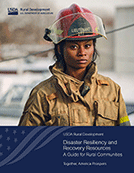
USDA unveiled a new resource guide as part of National Preparedness Month to help rural communities seeking disaster resiliency and recovery assistance. The resource guide outlines USDA Rural Development (RD) programs and services that can help rural residents, businesses and communities impacted by disasters and support long-term planning and recovery efforts. A resource matrix categorizes RD programs that can support preparedness and recovery through four key assistance types:
- housing assistance, and community and economic development planning;
- infrastructure and equipment financing;
- industry, entrepreneurship and local business development; and
- education and training.
The guide also includes information on technical assistance providers and other federal agencies that work with USDA to support rural communities in disaster planning and recovery efforts. It features examples of how customers have used USDA programs to support their recovery efforts, including USDA RD assistance to USVI communities post-Irma & Maria! Our RD Puerto Rico colleagues have also translated the guide to Spanish. Learn more…
^ back to top
|

All producers are encouraged to contact their local USDA-FSA office for more information on the final planting date for specific crops. The final planting dates vary by crop, planting period and county so please contact your local FSA office for a list of county-specific planting deadlines. The timely planting of a crop, by the final planting date, may prevent loss of program benefits.
^ back to top
|
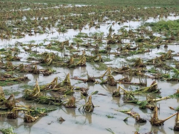
The Farm Service Agency’s (FSA) Noninsured Crop Disaster Assistance Program (NAP) helps you manage risk through coverage for both crop losses and crop planting that was prevented due to natural disasters. The eligible or “noninsured” crops include agricultural commodities not covered by federal crop insurance.
You must be enrolled in the program and have purchased coverage for the eligible crop in the crop year in which the loss incurred to receive program benefits following a qualifying natural disaster.
NAP Buy-Up Coverage Option
NAP offers higher levels of coverage, from 50 to 65 percent of expected production in 5 percent increments, at 100 percent of the average market price. Buy-up levels of NAP coverage are available if the producer can show at least one year of previously successfully growing the crop for which coverage is being requested. Producers of organics and crops marketed directly to consumers also may exercise the “buy-up” option to obtain NAP coverage of 100 percent of the average market price at the coverage levels of between 50 and 65 percent of expected production. Buy-up coverage is not available for crops intended for grazing. For NAP application, eligibility and related program information, contact your local USDA-FSA office or visit www.fsa.usda.gov/nap.
^ back to top
|

ELAP provides emergency assistance to eligible livestock, honeybee, and farm-raised fish producers who have losses due to disease, adverse weather or other conditions, such as blizzards and wildfires, not covered by other agricultural disaster assistance programs.
Eligible losses include:
-
Livestock - grazing losses not covered under the Livestock Forage Disaster Program (LFP), loss of purchased feed and/or mechanically harvested feed due to an eligible adverse weather event, additional cost of transporting water because of an eligible drought and additional cost associated with gathering livestock to treat for cattle tick fever.
-
Honeybee - loss of purchased feed due to an eligible adverse weather event, cost of additional feed purchased above normal quantities due to an eligible adverse weather condition, colony losses in excess of normal mortality due to an eligible weather event or loss condition, including CCD, and hive losses due to eligible adverse weather.
-
Farm-Raised Fish - death losses in excess of normal mortality and/or loss of purchased feed due to an eligible adverse weather event.
Contact your local USDA-FSA office if you’ve suffered eligible livestock, honeybee, or farm-raised fish losses during calendar year 2021. You must file:
- A notice of loss within 30 calendar days after the loss is apparent (15 days for honeybee losses).
- An application for payment by Jan. 30, 2022.
^ back to top
|
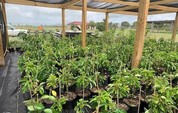
As Virgin Islanders mobilize to increase their food security, the University of the Virgin Islands’ Caribbean Green Technology Center and the Community Foundation of the Virgin Islands teamed up to aid farmers and families by donating more than 850 fruit trees on St. Thomas, St. John, and St. Croix. Farmers and residents received mango, avocado and papaya trees to increase their orchards or home gardens. The trees will support the rebuilding of farms across the territory, many of which were devastated by the 2017 hurricanes. Once mature, fruits from the trees will improve access to healthy fresh food and increase agricultural production in the USVI. To identify families to receive the trees, the project was paired with a USDA National Institute of Food and Agriculture emergency COVID-19 grant program designed to aid families in dealing with mental health issues and isolation during the pandemic so they could get involved in gardening while sheltering in place. Learn more...
^ back to top
|
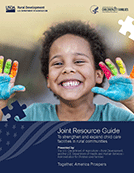
USDA Rural Development and Department of Health and Human Services unveiled a joint resource guide on Sep. 21 to help people in rural and Tribal communities increase access to child care services.
Luis R. García, USDA Rural Development Puerto Rico State Director, indicated that this joint resource guide follows the Biden-Harris Administration’s announcement of the American Families Plan (AFP). The guide responds to the AFP, which targets investments to support America’s children and families – helping families cover the basic expenses that so many struggle with now, including lowering health insurance premiums and continuing the American Rescue Plan’s historic reductions in child poverty. Learn more at www.rd.usda.gov.
^ back to top
|
Oct. 6, 2021. USDA Rural Development - Puerto Rico Virtual Listening Session for Farmers, 2:00 p.m. Learn more at: https://www.rd.usda.gov/newsroom/news-release/usda-seeks-comment-ways-help-rural-agricultural-producers-increase-income-and-expand-markets-0
Oct. XX, 2021. Arecibo Local Working Group (LWG) Meeting, TIME and PLACE.
Oct. 25, 2021. Racial Justice & Equity Grant Application Deadline.
Oct. 27, 2021. Mayagüez Local Working Group (LWG) Meeting, 10:00 a.m. - 12:00p.m., Mayagüez Field Office. Contact DC Zulma García at 787-396-8781 or zulma.garcia@usda.gov for details.
Oct. 29, 2021. FY 2022 CSP & EQIP Period 1 Signup Deadline.
|